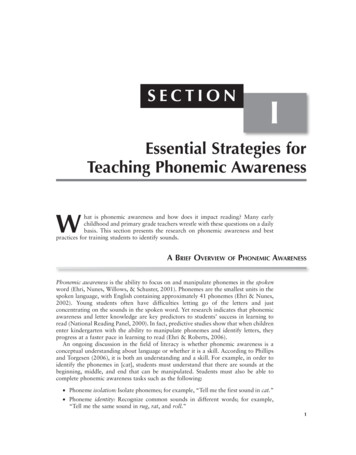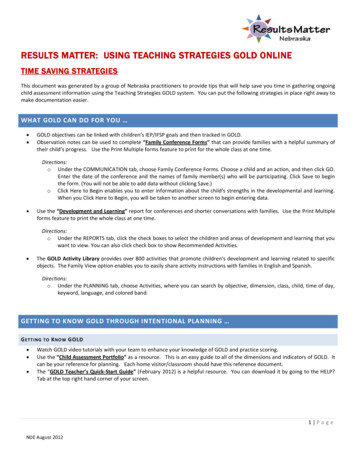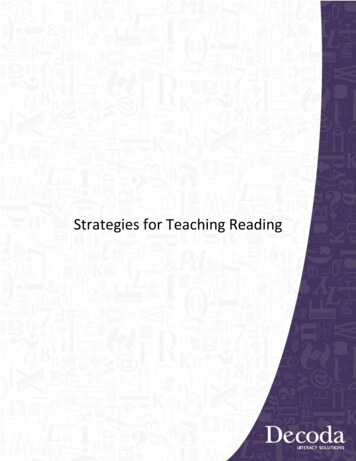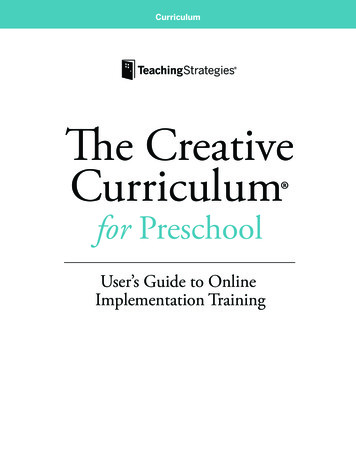
Transcription
SECTIONIEssential Strategies forTeaching Phonemic AwarenessWhat is phonemic awareness and how does it impact reading? Many earlychildhood and primary grade teachers wrestle with these questions on a dailybasis. This section presents the research on phonemic awareness and bestpractices for training students to identify sounds.A Brief OverviewofPhonemic AwarenessPhonemic awareness is the ability to focus on and manipulate phonemes in the spokenword (Ehri, Nunes, Willows, & Schuster, 2001). Phonemes are the smallest units in thespoken language, with English containing approximately 41 phonemes (Ehri & Nunes,2002). Young students often have difficulties letting go of the letters and justconcentrating on the sounds in the spoken word. Yet research indicates that phonemicawareness and letter knowledge are key predictors to students’ success in learning toread (National Reading Panel, 2000). In fact, predictive studies show that when childrenenter kindergarten with the ability to manipulate phonemes and identify letters, theyprogress at a faster pace in learning to read (Ehri & Roberts, 2006).An ongoing discussion in the field of literacy is whether phonemic awareness is aconceptual understanding about language or whether it is a skill. According to Phillipsand Torgesen (2006), it is both an understanding and a skill. For example, in order toidentify the phonemes in [cat], students must understand that there are sounds at thebeginning, middle, and end that can be manipulated. Students must also be able tocomplete phonemic awareness tasks such as the following: Phoneme isolation: Isolate phonemes; for example, “Tell me the first sound in cat.” Phoneme identity: Recognize common sounds in different words; for example,“Tell me the same sound in rug, rat, and roll.”1
2 P r o m o t i n g L i t e r a c y D e v e l o p m e n t Phoneme categorization: Identify the word with the odd sound in a sequence; forexample, “Which word does not belong in sat, sag, rug?” Phoneme blending: Combine separate sounds to form a word; for example, [b-a-t]for bat. Phoneme segmentation: Break out the word into separate sounds; for example,“What are the sounds in bag?” (Ehri et al., 2001)There is also a developmental progression for young children in tackling thesephonemic awareness tasks. Research indicates that identifying beginning and endingsounds is much easier than recognizing medial phonemes (Inverizzi, 2003). This findingpoints to the need for explicit, systematic instruction in phonemic awareness that isintegrated within a literacy program (National Reading Panel, 2000).InstructioninPhonemic AwarenessMany students enter preschool or kindergarten having already obtained knowledge ofletters and sounds through language play or exposure. However, for those who needthese concepts and skills, explicit, systematic instruction in phonemic awareness will benecessary (Phillips & Torgesen, 2006). It is critical to know that older striving readersand English language learners also benefit from phonemic awareness training. Researchshows that when English language learners are provided explicit phonemic awarenessinstruction, they are able to catch up with native speakers’ progress on word identi fication and spelling (Geva & Siegel, 2000).The key to success is data-driven instruction that uses assessment to determinestudents’ level of phonological awareness. Phonological awareness is the broaderconstruct for knowing speech sounds, rhyming, and alliteration and includes phonemicawareness (Inverizzi, 2003). When teachers use data to inform instruction, targetedsessions are implemented on specific needs such as phoneme blending or categorization.It is also important to note that data may determine that some students do not requireinstruction in phonemic awareness as they already possess the concept and skill.According to the National Reading Panel (2000), effective phonemic awarenessinstruction occurs in small groups and is combined with letter identification to aidtransfer of skills to reading. This chapter presents several strategies that use guidelinesformed from research on best practice to instruct students in identifying andmanipulating sounds.GuidelinesforTeaching Phonemic AwarenessDuring the past several years, a body of research indicates that early, systematic, explicitphonemic awareness instruction can successfully jump-start emergent and early readers’reading performance (McGee & Ukrainetz, 2009). The following guidelines provide theframework for phonemic awareness instruction:1. Analysis of phonemic awareness assessment data should drive instruction, as onlya small percentage of students need explicit instruction (Ehri & Roberts, 2006).2. Phonemic awareness instruction should be a positive, enriching experience thatallows students to engage in language play (Yopp, 1992).
Section I Essential Strategies for Teaching Phonemic Awareness 33. Effective phonemic awareness instruction provides for individual differences inabilities and uses leveled scaffolding to facilitate growth (McGee & Ukrainetz,2009).4. Developmentally appropriate phonemic awareness instruction uses chants, poetry,songs, and rhymes to engage students’ curiosity about language and to developmetalinguistic awareness (Yopp & Yopp, 2000).5. Effective phonemic awareness instruction explicitly labels sounds and demonstrates the process of blending-segmenting of sounds (Ehri et al., 2001).A StrategyforAssessing Phonemic AwarenessResearch indicates that phonemic awareness tasks are the best predictors of students’success with reading acquisition (Yopp, 1995). Due to its critical nature, it is imperativethat teachers assess students’ phonemic awareness skills in order to differentiateinstruction or to provide intervention if necessary (Ehri et al., 2001). The purpose ofassessing phonemic awareness may be to screen for targeted instruction or to conductprogress monitoring. The Phonemic Awareness Checklist shown in Figure I.1 may beused for either formative or summative assessment. However, teachers need to analyzeand reflect on the data to denote patterns among students. For example, if students arestruggling with a particular subskill, such as blending and segmenting phonemes,teachers may need to reteach the skill before selecting students for small-groupinstruction.A GuideforUsing Response to Interventionfor Phonemic AwarenessAfter analyzing the data from the Phonemic Awareness Checklist (Figure I.1), studentsat the developing or beginning levels may be selected for intervention. The instructorgroups students with similar needs, such as blending or segmenting phonemes, and usesthe Sound Sorts activity to target specific sounds. Instructors may choose to begin withpicture sorts if students are in the beginning stage. Learners that were evaluated as“developing” may begin with sound sorts without picture clues. In this section,“Essential Strategies for Teaching Phonemic Awareness,” five instructional strategies arepresented to facilitate phonological awareness. The strategies, which are based on dataanalysis of student needs, are presented as guides for teachers to use.Professional ResourcesAdams, M., Foorman, B., Lundgerg, I., & Beeler, T.(1997). Phonemic awareness in young children: Aclassroom curriculum. Baltimore, MD: Brookes.Blevins, W. (1999). Phonemic awareness activities forearly reading success. New York: Scholastic.Florida Center for Reading Research. (2009). FloridaCenter for Reading Research. Retrieved from http://www.fcrr.orgJustice, L., & Sofka, A. (2010). Engaging children withprint: Building early skills through read-alouds. NewYork: Guilford.Scott, V. (2009). Phonemic awareness: Ready-to-uselessons, activities, and games. Thousand Oaks, CA:Corwin.
4 P r o m o t i n g L i t e r a c y D e v e l o p m e n tFigure I.1PHONEMIC AWARENESS CHECKLISTDirections: Observe the student perform a phonemic awareness task focused on the appropriate subcomponent. Based on observational data from a minimum of three sessions, evaluate the student’s performanceas Beginning, Developing, or Proficient.PA sStudent rarelyidentifies words asrhyming.(1 point)Student sometimesidentifies words asrhyming.(2 points)Student always identifieswords as rhyming.(3 points)GeneratingRhymesStudent rarelygenerates rhymingwords.(1 point)Student sometimesgenerates rhymingwords.(2 points)Student alwaysgenerates rhymingwords(3 points)IdentifyingPhonemesStudent rarelyidentifies targetedphoneme.(1 point)Student sometimesidentifies targetedphoneme.(2 points)Student always identifiestargeted phoneme.(3 points)Student rarelymanipulatesphonemes in initial/media/final position.(1 point)Student sometimesmanipulatesphonemes in initial/media/final position.(2 points)Student alwaysmanipulates phonemesin initial/media/finalposition.(3 points)BlendingPhonemesStudent rarely blendssegmented sounds tomake whole word.(1 point)Student sometimesblends segmentedsounds to make wholeword.(2 points)Student always blendssegmented sounds tomake whole word.(3 points)SegmentingPhonemesStudent rarelysegments words intoindividual phonemes.(1 point)Student sometimessegments words intoindividual phonemes.(2 points)Student always segmentswords into individualphonemes.(3 points)ManipulatingPhonemesProficient 18–13 pointsDeveloping 12–7 pointsBeginning 6–1 pointsReferencesEhri, L., & Nunes, S. (2002). The role of phonemicawareness in learning to read. In A. E. Farstrup & S. J.Samuels (Eds.), What research has to say about readinginstruction (pp. 110–140). Newark, DE: InternationalReading Association.Ehri, L., Nunes, S., Willows, D., & Schuster, B. (2001).Phonemic awareness instruction helps children learn toread: Evidence from the National Reading Panel’s metaanalysis. Reading Research Quarterly, 36, 250–287.Ehri, L., & Roberts, T. (2006). The roots of learning to readand write: Acquisition of letters and phonemic awareness.In D. Dickinson & S. Neuman (Eds.), Handbook of earlyliteracy research (Vol. 2, pp. 113–130). New York:Guilford.
Section I Essential Strategies for Teaching Phonemic Awareness 5Geva, E., & Siegel, L. (2000). Orthographic cognitive factorsin the concurrent development of basic reading skills intwo languages. Reading & Writing: An InterdisciplinaryJournal, 12, 1–30.Inverizzi, M. (2003). Concepts, sounds, and the ABCs: Adiet for the very young reader. In D. Barone & L. M.Morrow (Eds.), Literacy and young children: Researchbased practices (pp. 140–156). New York: Guilford.McGee, L., & Ukrainetz, T. (2009). Using scaffolding toteach phonemic awareness in preschool andkindergarten. The Reading Teacher, 62, 599–603.National Reading Panel. (2000). Teaching children toread. Washington, DC: National Institute of Healthand Human Development.Phillips, B., & Torgesen, J. (2006). Phonemic awarenessand reading: Beyond the growth of initial readingaccuracy. Handbook of early literacy research (Vol. 2,pp. 101–113). New York: Guilford.Yopp, H. K. (1992). Developing phonemic awareness inyoung children. The Reading Teacher, 45, 696–703.Yopp, H. K. (1995). A test for assessing phonemicawareness in young children. The Reading Teacher,49, 20–30.Yopp, H. K., & Yopp, R. H. (2000). Supporting phonemicawareness development in the classroom. The ReadingTeacher, 54, 130–143.
Strategy1Speaking Briefly: An OverviewRhyme Generationof theLiteracy StrategySource: International Reading Associationand National Council of Teachers of English(1996).Rhyme Generation is an instructional strategy that develops explicit phonemicawareness skills. During this activity, students are engaged in isolating, blending, andmanipulating sounds on several levels. Students first identify the rhyme within anauthentic context, such as a poem or song. Playing with language enables students topractice making words through rhyme generation.The primary purpose for implementing the rhyme generation activity is to encouragestudents to develop critical phonemic awareness skills such as manipulation of the onsetand rime. The onset is the beginning sound/letter, such as /b/ in bat. The rime is the stemof the word, such as [at] in bat. Identification of rhymes is a foundational phonemicawareness skill that many students pick up through language play (Ehri & Roberts,2006). Rhyme generation typically occurs during the morning message or sharedreading time. However, it can be implemented during intervention sessions with studentsof varying ages who need additional instruction in phonemic awareness.2. Students read a wide range of literature from many periods in many genres to build an understanding of the many dimensions (e.g., philosophical, ethical, aesthetic) of human experience.6. Students apply knowledge of language structure, language conventions (e.g., spelling andpunctuation), media techniques, figurative language, and genre to create, critique, and discussprint and nonprint texts.Using Rhyme GenerationWhen to use the strategy: Rhyme generation may be used during any segment of theliteracy block, depending on student needs. For example, teachers may choose to6
Strategy 1 Rhyme Generation 7demonstrate the activity during morning message and then coach students in thephonemic awareness skill during guided reading. Students may also engage in theactivity during literacy center time or as an intervention task.Strategy modifications for grade levels: The strategy may be modified for older studentsby using multisyllabic word families.ImplementingtheRhyme Generation Strategy: StepbyStep1. Introduce rhyme generation to students. Teachers present the concept of “rhyme”and ask students to define it and give examples.2. Present rhymes in context. Teachers conduct a shared reading of a poem or songand ask students to identify the rhymes.3. Demonstrate how to manipulate onset and rime. Teachers use the identifiedrhymes to color-code the onset and rime on chart paper. Using a word laddergraphic, teachers demonstrate how to generate new rimes from previous words.They list initial consonants and demonstrate how to manipulate the onset to create a new rhyme. For example, the word [fat] may be changed to [sat] by selectinga new onset.4. Record rhymes generated from original poem or song. Teachers display selectedsentences from the song or poem used to introduce the activity on sentence strips.Students apply the skill by creating their own sentence that generates a new rhymefor the context.5. Facilitate students’ application of rhyme generation. Teachers develop students’skill in manipulating onsets and rimes by encouraging rhyme generation with theirnames. During literacy stations or intervention, students use their own names togenerate rhymes on a word ladder. After exhausting the list for their own names,they may create a new list of rhymes with classmates’ names.Applying the Rhyme Generation Strategy:Kindergarten Lesson on Rhyme GenerationThe kindergarten teacher shows students a picture of Buckingham Palace in Londonand asks students if they know what it is and who lives there. After discussing thepicture, the teacher presents the poem “Buckingham Palace” (Milne, 2004) on chartpaper and asks students to define what makes a poem special. After introducing theconcept of rhymes, the teacher conducts a read-aloud of the poem. After the read-aloud,the teacher invites students to identify the rhymes by highlighting them with coloredmarkers. Using the word ladder graphic organizer shown in Figure 1.1, the teacherdirects students to do the following: Make a new word by changing the initial sounds in [came/same]. Use the rhymes to generate more words. Create a new sentence for the poem using the generated rhymes.After they have completed their sentences, students read their new rhyming sentences.The teacher records their generated rhymes on chart paper for students to reread duringliteracy station time.
8 S e c t i o n 1 E ss e n t i a l S t r at e g i e sforT e a c h i n g P h o n e m i c A wa r e n e ssFigure 1.1 Rhyming Words LadderRHYMING WORDS LADDERSource: International ReadingAssociation and National Councilof Teachers of English (1996).camebike10. Students whose first language is not English make use of their first language to developcompetency in the English language arts and to develop understanding of content across thecurriculum.Differentiating InstructionforEnglish Language LearnersResearch indicates that English language learners benefit from explicit phonemicawareness training (Geva & Siegel, 2000). In order to provide explicit instruction,teachers may need to scaffold English language learners’ understanding of rhyme.English language learners might need a picture sort activity to grasp the concept of“rhyme” before the Rhyme Generation lesson. In this activity, teachers guide studentsin sorting pictures into rhyming categories such as “box with fox.” Teachers may alsouse a picture sort activity to gather additional data on students’ phonemic awarenessskills and their grasp of oral vocabulary.Differentiating InstructionforStudents With Special NeedsStudents with special needs may need additional support in manipulating the onset andrime to generate new words. One method for differentiating this activity is to usemultisensory materials to enable them to acquire this phonemic awareness skill. Usingmagnetic letters with raised bumps helps students with special needs create new rhymesfrom a poem or song. The magnetic letters enable them to visualize the new words theyare creating as they transfer skills to reading.
Strategy 1 Rhyme Generation 9ReferencesEhri, L., & Roberts, T. (2006). The roots of learning to readand write: Acquisition of letters and phonemic awareness.In D. Dickinson & S. Neuman (Eds.), Handbook of earlyliteracy research (Vol. 2, pp. 113–130). New York:Guilford.Geva, E., & Siegel, L. (2000). Orthographic cognitivefactors in the concurrent development of basic readingskills in two languages. Reading & Writing: AnInterdisciplinary Journal, 12, 1–30.International Reading Association and National Councilof Teachers of English. (1996). Standards for theEnglish language arts. Newark, DE: InternationalReading Association and Urbana, IL: National Councilof Teachers of English.Children’s Literature CitedMilne, A. A. (2004). The complete poems for Christopher Robin. London: Folio Society.
Strategy2Multisensory MappingSpeaking Briefly: An Overviewof theLiteracy StrategySource: International Reading Associationand National Council of Teachers of English(1996).Multisensory Mapping uses all modalities (auditory, visual, kinesthetic-tactile) to facilitate retention and processing of sounds. Research confirms that the most common barrier to acquisition of emergent reading skills is the inability to process phonologically(Snow, Burns, & Griffin, 1998). Multisensory techniques such as tracing, illustrating,and chanting of sounds enable young learners to process sounds in multiple ways.As students play and manipulate sounds through the senses, they begin to grasp thealphabetic principle. Research indicates that emergent and striving readers experiencerapid growth in performance when they receive intensive, explicit training in phonemicawareness (Torgesen & Bryant, 1993). Multisensory Mapping may be used as an intervention strategy for dyslexic or striving readers. It should be implemented as a supplementary activity to provide students with multiple opportunities to process sounds,rather than as an introduction to phonemic awareness.1. Students apply knowledge of language structure, language conventions (e.g., spelling andpunctuation), media techniques, figurative language, and genre to create, critique, and discussprint and nonprint texts.11. Students participate as knowledgeable, reflective, creative, and critical members of a variety ofliteracy communities.Using Multisensory MappingWhen to use the strategy: Multisensory Mapping may be presented as a literacy stationactivity after it has been demonstrated for the students. Teachers may also choose to10
Strategy 2 Multisensory Mapping 11implement this strategy in a tutorial session with a striving reader who requiresadditional support to retain and manipulate sounds.Strategy modifications for grade levels: The strategy may be modified for older studentsby using technology such as digital cameras or computer software to match letters andsounds.ImplementingtheMultisensory Mapping Strategy: StepbyStep1. Present the target sound in context. Teachers and students join in a poem or songas keywords are highlighted. After singing the song or chanting the poem, theteacher leads students in a choral reading.2. Select target sounds. Teachers select target sounds such as “c” or “t” from keywords in the song or poem and identify them for students.3. Match letter and sound. Teachers call on individual students to match the targetsound with a picture in a sound sort activity. After the sound sort activity, studentswrite the letter that represents the sound in the air, chanting the sound at the sametime.4. Trace the letter. Teachers invite individual students to use cornmeal to trace theletter as they recite the sound. Immediately after tracing the letter, students generate words that begin or end with the target sound.5. Review target sounds and letters. Teachers distribute pictures and letter cards withraised bumps or sandpaper. Students work with partners to repeat the process asa review. Previous sounds and letters should be added to the review.Applying the Multisensory Mapping Strategy:First-Grade Lesson on Multisensory MappingStudents gather on the rug as the teacher leads them in a read-aloud of the nurseryrhyme “Jack Be Nimble” (Adams, Foorman, Lundberg, & Beeler, 1998). The teacherdemonstrates movements to accompany the read-aloud so that students use whole-bodylearning to map the rhymes. After color-coding rhyming pairs in the poem, the teacherprovides each student with a packet. The packet contains a set of multisensory rhymingpair cards. Using the Multisensory Mapping of Sounds guide shown in Figure 2.1, theteacher directs students to work with their reading partners on the following: Match the rhyming pair cards with their pictures (box, fox). Use the magnetic letters to create the words and trace them. Chant the sounds as you trace the letters (box, fox). Create new words on your Rhyming Pair Word Study sheet that match (box, fox).As students complete their packets, they review the original nursery rhyme “Jack BeNimble” on the chart. Partners try out new lines for the rhyme with their generatedrhymes and add them to the chart. When all students have completed their task, theteacher gathers them on the rug again to read the new rhyming lines generated by theclass.
12 S e c t i o n 1 E ss e n t i a l S t r at e g i e sforT e a c h i n g P h o n e m i c A wa r e n e ssFigure 2.1 Multisensory Mapping of SoundsSource: International ReadingAssociation and National Councilof Teachers of English (1996).Picture CardWordRhyming WordFoxBoxFrogHogKnotHot10. Students whose first language is not English make use of their first language to developcompetency in the English language arts and to develop understanding of content across thecurriculum.Differentiating InstructionforEnglish Language LearnersTechnology provides the English language learner with multisensory experiences(Hodge, 1998). As second-language learners see the printed word on the text, type intheir rhyme, and listen to accompanying songs or stories, they are provided with multiple exposures to sounds. Interactive word-building activities such as “Construct aWord” on the Read/Write/Think website (www.readwritethink.org) enable secondlanguage learners to generate words that match the rhyme. This website provides feedbackon each response and also tallies scores. The teacher can provide further remediation with
Strategy 2 Multisensory Mapping 13a follow-up podcast of rhyming pairs with an accompanying word sheet so Englishlanguage learners can practice repeated readings.Differentiating InstructionforStudents With Special NeedsSimilarly to English language learners, students with special needs also benefit fromrepeated exposure to multisensory mapping of sounds (Daly, Chafouleas, & Skinner,2005). One intervention method for students with special needs is to use the song “OldMacDonald Had a Farm” (Yopp, 1992) to generate rhymes and wordplay. After listening to a podcast of the song, striving readers use their multisensory rhyming pairs tocreate a flip book. The flip book has pictures of the rhyming animals with color-codedtext. Students with special needs swap their flip books with one another for continuedpractice in wordplay and rhyming.ReferencesAdams, J. M., Foorman, R. B., Lundberg, I., & Beeler, T.(1998). Phonemic awareness in young children.Baltimore, MD: Paul H. Brooks.Daly, E., Chafouleas, S., & Skinner, C. (2005).Interventions for reading problems: Designing andevaluating effective strategies. New York: Guilford.Hodge, M. (1998). Teaching foreign language to at-risklearners: A challenge for the new millennium. Inquiry,2, 68–78.International Reading Association and National Councilof Teachers of English. (1996). Standards for theEnglish language arts. Newark, DE: InternationalReading Association and Urbana, IL: National Councilof Teachers of English.Snow, C., Burns, M., & Griffin, P. (1998). Preventingreading difficulties in young children. Washington,DC: National Academy Press.Torgesen, J. K., & Bryant, B. R. (1993). Individual difference variables that predict response to training inphonological awareness. Journal of ExperimentalChild Psychology, 63, 1–21.Yopp, H. K. (1992). Developing phonemic awarenessin young children. The Reading Teacher, 45,696–703.
Strategy3Picture Card SnapSpeaking Briefly: An Overviewof theLiteracy StrategySource: International Reading Associationand National Council of Teachers of English(1996).Picture Card Snap provides emergent and early readers with scaffolded practice in identifying and categorizing sounds. Young children often struggle with phonemic awareness activities since we are asking them to treat speech sounds as objects to bemanipulated (Yopp, 1992). However, research indicates that with specific training inidentifying and manipulating sounds, young readers make significant progress in reading and sound spelling at a much earlier age (McGee & Ukrainetz, 2009).Picture Card Snap provides emergent and early readers with specific, repeated practice in matching initial, medial, or final sounds to pictures. An integral component ofthe instructional strategy is the levels of scaffolding that are provided to the young readers as they attempt to complete the card game. As teachers use assessment data to layertheir prompts during this activity, young readers receive differentiated feedback toimprove their performance. Picture Card Snap should be used as a small-group activityor for intervention tutorials. Once students have participated in the scaffolded activity,the card game may be used as a literacy center activity during the literacy block.6. Students apply knowledge of language structure, language conventions (e.g., spelling andpunctuation), media techniques, figurative language, and genre to create, critique, and discussprint and nonprint texts.11. Students participate as knowledgeable, reflective, creative, and critical members of a variety ofliteracy communities.Using Picture Card SnapWhen to use the strategy: Picture Card Snap uses the group setting to encourage students to play with speech sounds. It is imperative that teachers encourage and positively14
Strategy 3 Picture Card Snap 15reinforce young readers’ attempts to identify and categorize speech sounds during thispicture card activity.Strategy modifications for grade levels: The card activity can be differentiated for challenge level by asking students to match the target sound in all positions (initial, medial,final) or by including several sound card matches.ImplementingthePicture Card Snap Strategy: StepbyStep1. Analyze assessment data. During the planning process, teachers examine assessment data to determine the speech sound to be the focus of the card activity (initial, medial, or final). Teachers also analyze the data to gauge the levels ofscaffolding needed by individual students.2. Prepare picture cards. Teachers select pictures to represent target sounds and“odd-man out” pictures to complete the pack of cards.3. Model identification of sound. Teachers explicitly model the target sound. Forexample, if the target sound is initial [b], teachers will prompt, “I will lookfor pictures that begin with the sound of [bbb] as in boy,” elaborating the soundfor emphasis.4. Match sounds and pictures. Teachers model taking turns to draw a card from theface-down pile and place it on the face-up pile. When a newly drawn card has thesame targeted beginning, medial, or final sound as the top card in the face-up pile,the first child to identify and match the sound says “SNAP!” and takes the wholepile of cards.5. Review target sounds. After students have completed the card activity, teachersfacilitate a review of the sound matches by asking individuals to report their matches.Applying the Picture Card Snap Strategy:Kindergarten Intervention ActivityAfter analyzing assessment data from the prior week’s lessons, the teacher selects agroup of three students who did not achieve benchmark on isolating and manipulatinginitial sounds. The teacher creates a Picture Card Snap card pack (see Figure 3.1) basedon assessment data, then gathers the small intervention group and provides the following scaffolding: Let’s identify the sound at the beginning of [moon]. [Mmm] is the first sound wehear in [moon]. Let’s all say it together: [mmm]. Can you think of other words that have the same initial sound as [moon]? Teachertakes several oral responses.
read (National Reading Panel, 2000). In fact, predictive studies show that when children enter kindergarten with the ability to manipulate phonemes and identify letters, they progress at a faster pace in learning to read (Ehri & Roberts, 2006). An ongoing discussion in the field of literacy is whether phonemic awareness is a










